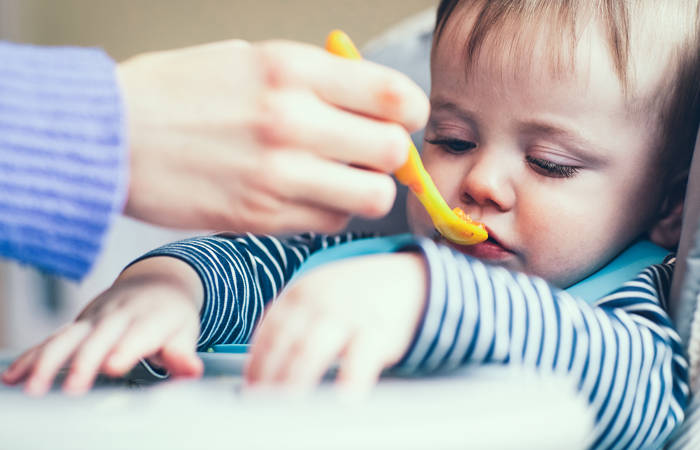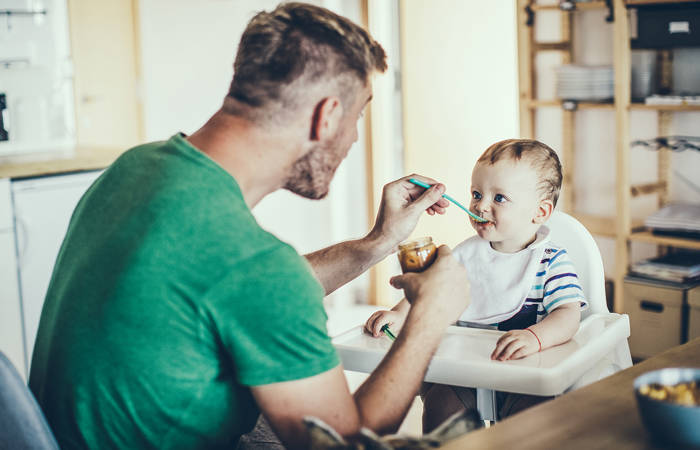Like what you see?
Sign up to receive more free parenting advice.
Thank you for subscribing to our newsletter!
Child Development

Credit: iStock.com/Vasyl Dolmatov
Nicole Bentley is responsible for the management of the Nutrition Services offered at Nutrition Australia Qld. In this article she looks at how to talk to children about healhty food choices.
It’s important that our children love and embrace their bodies. Understanding how their bodies work and that bodies come in different shapes will help our children have a positive body image and attitude towards health.
But how do we get our children to understand how our bodies work, and what it means to be ‘healthy’?
It is well known that we all (including our children) should be eating ‘more healthy foods and less junk food’. The National Health and Medical Research Council (NHMRC) has a wealth of evidence- based information called the ‘Australian Dietary Guidelines’ which are a great basis for all Australians to use when determining what they need to eat for optimal health.1
Young children need foods that enable their bodies to grow and thrive. The types of food a child needs are the same as for adults. If we look at the Australian Dietary Guidelines it becomes clear that just like adults, children need foods from the five food groups every day, and it’s important to limit the intake of foods high in saturated fat, sugar and salt – what we often call ‘sometimes’ foods – which means not eating them every day. 1
For information on serve size and the amount of food form each food group that young children need to eat visit: www.eatforhealth.gov.au
But what does this actually mean for our children?
We are all aware of the need to eat more fruits and vegetables; this continues to be a hot topic of discussion for many. There is a bombardment of information available for parents on topics such as: how to get your child to eat more vegetables, healthy snack ideas, the importance of breakfast and so on. But, do we take the time to stop and wonder what this means to our children. How do they interpret the usual dinner time phrases of ‘you need to eat your vegetables?’.
- Do our children understand why they need to eat these foods though?
- Do our children understand why some foods are ‘healthy /everyday foods’ and other foods are ‘sometimes’ foods?
- Do our children automatically assume that if they eat too much chocolate or lollies then they will become overweight?
Now, it is important that children eat a healthy diet, this is crucial for their growth and development and health later in life. The point to highlight though is, are we putting too much of an emphasis on our children ‘eating their fruits and vegetables’ rather than learning to enjoy all foods in the recommended amounts.
Unlike most adults, if allowed to eat according to their appetite, children are able to decide how much food they need for activity and growth. Forcing children to ‘clean their plate’ or giving sweets as rewards for ‘eating their vegetables’ can develop negative or positive associations with certain foods and may lead to problems of overeating later in life.Nicole Bentley
Stay up to date with the latest news and articles from First Five Years
Thank you for subscribing to our newsletter!
Teaching our children to enjoy all foods will help them to have a ‘healthy’ relationship with food.
Teaching our children about ‘healthy eating ‘, along with the five food groups should include strategies that include a ‘healthy relationship with food’ such as:
Mindful eating
Asking your child think about the taste, texture and feel of the food in their mouth.
When your child is eating ask questions like:
- How does it feel – hard, crunchy, soft, slimy?
- Is it hot or cold?
- How does it sound – loud, no sound
- What teeth are you using to eat it – the front, side or back molars?
Asking you child these questions will help them understand food is more than the flavour of what they are eating, the food textures provide many other experiences of eating rather than the flavour.
Positive reinforcement
Use phrases with your child like ‘you can try the new food’, ‘well done for having a nibble’. If your child doesn’t like a food, that is ok. Try again another time, or it may be that they don’t like that particular food. As a parent – we have foods we don’t like, so it is ok for our children to have their own likes and dislikes.
Learning the food their body needs for growth and development
Tell your child that eating the food their body needs will help them:
- Be strong
- Have a tummy that isn’t sore
- Have energy to play and be active
Tell them that using a fork when they eat will help them learn how to hold a pencil.
Teach your child to appreciate everything their body can do – it can breathe, move and think.
To be strong, to run faster.
Unlike most adults, if allowed to eat according to their appetite, children are able to decide how much food they need for activity and growth. Forcing children to ‘clean their plate’ or giving sweets as rewards for ‘eating their vegetables’ can develop negative or positive associations with certain foods and may lead to problems of overeating later in life.
Allow your child to decide how much food is enough. This shouldn’t cause problems for most children if a variety of healthy foods are consistently offered.
If needed, offer a small serve first and give your child more if they are hungry. Meal sizes will vary, as the amount of food a child needs depends on what else has been eaten during the day. Teach your child that sometimes members of the family will have different portion sizes of foods because that’s what ‘their’ body needs.
How to have a positive body image
Research shows, our children’s body size attitudes are being formed very early in childhood and are related to the attitudes of their parents. This highlights the need for parents to create an environment that supports the development of healthy body size attitudes and body image. 2
The most crucial thing we need to do with our children is promote body inclusivity and body acceptance. If we accept our body for what it is (regardless of its weight) we are more likely to actually do healthy things like eat nutritious food and exercise.
Children are bombarded with information including books, TV and online, all of which contribute to their idea of what a body should look like. Your child may not be old enough to understand that these images aren’t real life. It is a parent’s job to teach our children that these types of characters (i.e. the Barbie types) and those on the TV aren’t real life, and we don’t need to be like them or look like them.
Talk to your child about body acceptance and inclusivity by using phrases like:
- Everyone’s body comes in different sizes.
- Everyone is ‘made different’ and that’s ‘normal’ and ok.
- Everyone is going to eat different amounts of food, the main thing is that we eat the food our body needs .
- People have different coloured hair, different coloured skin, can be short or tall etc. It is just the way we are all made.
- We don’t judge people by how they look, it is who they are as a person – are they kind, caring or helpful.
Teach your child that health is more than their tummy size, it’s how they feel in their mind, the friendships they have and energy they have.
Play is a critical factor in a young child’s life and the more they treat their body kindly by eating whole foods from the five food groups, the more energy they will have to play and learn, and build lasting friendships and relationships.
What can we do as parents
As parents we need to be praising our children on their achievements, not over how they look.
Instead of saying ‘that is a pretty dress’, tell our children that they are strong, brave, courageous, amazing, patient, honest, creative, helpful, generous or helpful.
Speaking positively to your children about healthy foods, role modelling balanced eating, and using positive language when talking about your body is the first step in helping kids develop a healthy relationship with food and their bodies. And remember, actions speak louder than words! Children watch, listen and learn through observation, and then follow what they see. Set your children up for life by being a positive role model and create healthy habits from the start.
If a child has a positive body image, it means they can accept, appreciate and respect their body, and they will do so for the children and others around them.
1 National Health and Medical Research Council (2012) Infant Feeding Guidelines. Canberra: National Health and Medical Research Council. Accessed from: https://www.nhmrc.gov.au/about-us/publications/infant-feeding-guidelines-information-health-workers
2 Damiano, S. R., Gregg, K. J., Spiel, E. C., McLean, S. A., Wertheim, E. H., & Paxton, S. J. (2015). Relationships between body size attitudes and body image of 4-year-old boys and girls, and attitudes of their fathers and mothers. Journal of Eating Disorders, 3(16). https://doi.org/10.1186/s40337-015-0048-0








